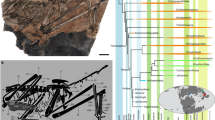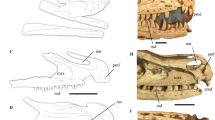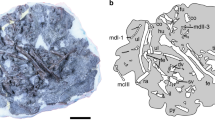Abstract
Current classification of birds recognizes four subclasses: the Archaeornithes, the Enantiornithes, the Odontornithes and the Neornithes. Three of these subclasses were proposed during the nineteenth century, but the Enantiornithes was proposed only five years ago, based on material from the Lecho Formation (Maas-trichtian) of Salt a Province in Argentina1. Further material from Asia (Mongolia) and North America (Mexico) has been referred to the Enantiornithes2, all of it from the Campanian. Now, in addition, a small tibiotarsus found in the Lower Cretaceous (Albian) of Queensland not only represents the first bony material of Mesozoic birds from Australia, but is also the first reported occurrence of an enantiornithine bird in the Lower Cretaceous.
This is a preview of subscription content, access via your institution
Access options
Subscribe to this journal
Receive 51 print issues and online access
$199.00 per year
only $3.90 per issue
Buy this article
- Purchase on Springer Link
- Instant access to full article PDF
Prices may be subject to local taxes which are calculated during checkout
Similar content being viewed by others
References
Walker, C. A. Nature 292, 51–53 (1981).
Martin, L. D. in Perspectives in Ornithology, 291–338 (Cambridge University Press, 1983).
Molnar, R. E. & Thulborn, R. A. Nature 288, 361–363 (1980).
Talent, J. A., Duncan, P. M. & Handby, P. L. The Emu 66, 81–86 (1966).
Waldman, M. Condor 72, 377 (1970).
Rich, P. V. Proc. 16th int. orn. Congr. 53–65 (Australian Academy of Science, 1976).
Elzanowski, A. Acta palaeont. pol. 28, 75–92 (1983).
Galton, P. M. Palaeont. Z. 54, 331–342 (1980): Pls. 2M & 20.
Padian, K. Postilla 189, 1–44 (1983).
Senior, B. R., Mond, A. & Harrison, P. L. Bull Bur. Miner. Resour. Geol. Geophys. Aust. 167, 1–102 (1978).
Elzanowski, A. Nature 264, 51–53 (1976); Palaeont. pol 42, 147–179 (1981).
Brodkorb, P. Smithson. Contr. PaleobioL 27, 67–83 (1976).
Molnar, R. E., Flannery, T. F. & Rich, T. H. Alcheringa 5, 141–146 (1981); J. Paleont. 69, 1513–1515 (1985).
Bonaparte, J. F. Science 205, 1377–1379 (1979).
Kemp, A. & Molnar, R. E. J. Paleont. 55, 211–217 (1981).
Author information
Authors and Affiliations
Rights and permissions
About this article
Cite this article
Molnar, R. An enantiornithine bird from the Lower Cretaceous of Queensland, Australia. Nature 322, 736–738 (1986). https://doi.org/10.1038/322736a0
Received:
Accepted:
Issue Date:
DOI: https://doi.org/10.1038/322736a0
This article is cited by
-
Fossil that fills a critical gap in avian evolution
Nature (2001)
Comments
By submitting a comment you agree to abide by our Terms and Community Guidelines. If you find something abusive or that does not comply with our terms or guidelines please flag it as inappropriate.



